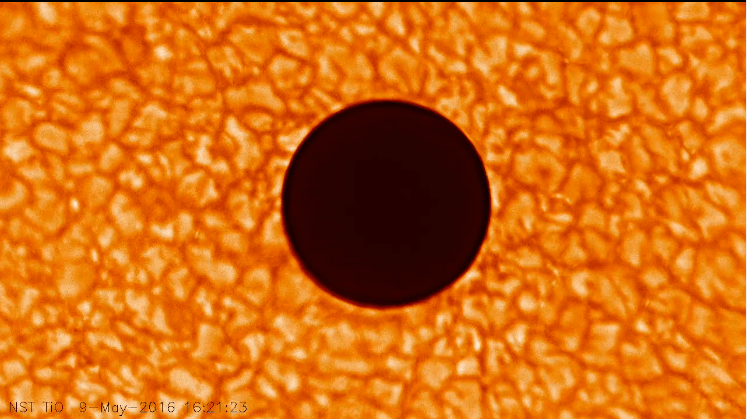Just. Wow.
Just when we thought we'd seen
every amazing image and video sequence
from Monday's transit of Mercury, a new one surfaces that makes our jaw hit the floor.
The folks at the
Big Bear Solar Observatory
may have just won the internet this week with this
amazing high-definition view
of Mercury racing across the surface of the Sun:
Remember,
Mercury
is tiny a world, just 1.4 times the diameter of our
Moon
, at 4,880 kilometers across. At about 9" arc seconds across during the transit, it took Mercury seven and a half hours to race across the 30' (over 180 times the apparent size of Mercury as seen from the Earth) disk of the Sun.
The video has an ethereal three dimensional quality to it, as we seem to race along with the fleeting world. You can see the granulation in the dazzling solar photosphere whiz by in the background.
Big Bear Solar Observatory Telescope Engineer and Chief Observer Claude Plymate explains some of the technical aspects of the captured sequence:
"John Varsik assembled (the video) from our speckle reconstructed broadband filter images. The images were taken with a high speed PCO2000 CCD camera. Bursts of 100 frames were taken at a cadence of 15 seconds. After flat fielding and dark subtraction, speckle reconstruction is used on each burst to generate the final single frame. Exposure time was 1.0 ms through a broadband TiO (7057A, 10A FWHM) filter.
Our actual primary science data was data taken with a fast scanning spectrometer that very quickly produces 2D Na D-line maps. The objective was to measure the Na distribution in Mercury's exosphere in absorption."
So there's some science there as well, as measurements taken from Big Bear will make a fine comparison and contrast with NASA's measurements of the tenuous
exosphere of Mercury
measured by the MESSENGER spacecraft.
Based on the shores of Big Bear Lake in the San Bernardino Mountains 120 kilometers east of downtown Los Angeles, the
Big Bear Solar Observatory
employed the 1.6-meter New Solar Telescope (NST) to follow the transit. The NST is the largest clear aperture solar telescope in the world currently in use. Capable of resolving features on the Sun just 50 kilometers across, the mirror blank for the NST was figured at the Mirror Lab at the University of Arizona in Tucson and served as a proof of concept for the seven mirror
Giant Magellan Telescope
currently
under construction
.
[caption id="attachment_128862" align="aligncenter" width="580"]
The Big Bear Solar Observatory. Image Credit: The
NJIT/BBSO
[/caption]
The Big Bear Solar Observatory is managed under the New Jersey Institute of Technology and is funded by NASA, the United States Air Force and the National Science Foundation.
The Big Bear Solar Observatory is also part of the GONG (Global Oscillation Network Group), a series of observatories worldwide dedicated to observing the Sun around the clock. It's strange to think, but in a sense, we live inside the outer atmosphere of our host star, and knowing just what it's doing is of paramount importance to our modern technology-dependent civilization.
An awesome capture, with some amazing science to boot. Big Bear will also get a sunrise view of the November 11th, 2019 transit of Mercury as well:
[caption id="attachment_128863" align="aligncenter" width="580"]
Because it's never too early to start planning... here's the visibility prospects for the 2019 transit of Mercury. Image credit: Xavier Juber.[/caption]
Stay tuned!
Also check out
*Universe Today's* Flickr forum
for more amazing images of the transit of Mercury, and
Nancy Atkinson's roundup
of the view from the Solar Dynamics Observatory.
Video used with permission of the BBSO.
The BBSO operation is supported by NJIT, US NSF AGS-1250818, and NASA
NNX13AG14G grants, and the NST operation is partly supported by the Korea
Astronomy and Space Science Institute and Seoul National University and by
the strategic priority research program of CAS with Grant No.
XDB09000000".
 Universe Today
Universe Today
